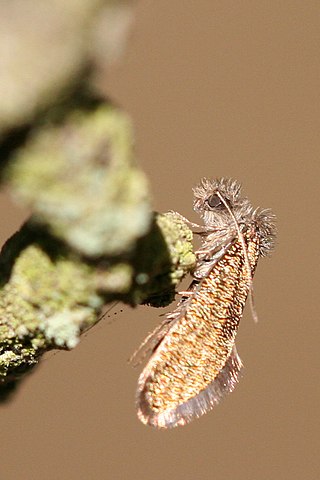
Dyseriocrania subpurpurella is a diurnal moth from the family Eriocraniidae, found in most of Europe. The moth was first named by the English entomologist, Adrian Hardy Haworth in 1828.

Eriocrania semipurpurella is a moth of the family Eriocraniidae, found from Europe to Japan and in North America. It was first described by James Francis Stephens in 1835. The species closely resembles Eriocrania sangii and the larvae of both species mine the leaves of birch.

The March dagger moth is a moth of the subfamily Chimabachinae. It is found in Europe and was first described by Michael Denis & Ignaz Schiffermüller in 1775.

Micropterix aruncella is a species of moth belonging to the family Micropterigidae, which is distributed throughout Europe. The imago was first described by Giovanni Antonio Scopoli in 1763. This species is one of the best known members of the family, being found in a wide range of habitats from sea level to over 2,000 metres (6,600 ft); the only habitat not favoured by this species is dense woodland.

Prays fraxinella, also known as the ash bud moth, is a moth of the family Plutellidae found in Europe. The larvae are leaf miners, feeding on the leaves and buds of ash trees.

Eriocrania sangii, the large birch purple, is a moth of the family Eriocraniidae found in Europe and described by John Henry Wood in 1891. The moth can be found flying in sunshine around birch trees and the larvae feed on birch leaves.

Eriocrania chrysolepidella is a moth of the family Eriocraniidae found in Europe. It was first described by the German entomologist, Philipp Christoph Zeller in 1851. The larvae mine the leaves of hazel and hornbeam.

Parornix anglicella is a moth of the family Gracillariidae found in Asia and Europe. It was described in 1850, by the English entomologist Henry Tibbats Stainton, from a specimen from Lewisham, Kent.
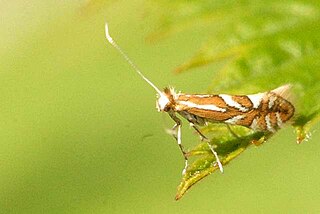
Phyllonorycter oxyacanthae is a moth of the family Gracillariidae found in all of Europe except the Balkan Peninsula. It was described by the German-born Swiss entomologist, Heinrich Frey in 1856. The larvae are known as leaf miners, living inside the leaves of their food plants.
Stigmella oxyacanthella is a moth of the family Nepticulidae, found in Europe and North America. The larvae are leaf miners feeding inside the leaves of trees and shrubs, such as hawthorn, apple and pear.
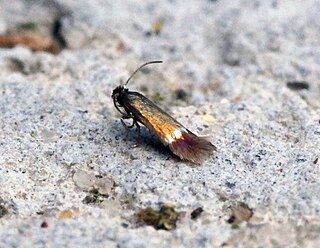
Stigmella hybnerella also known as the greenish thorn pigmy is a moth of the family Nepticulidae. It is found in all of Europe, in North Africa, the Near East, and the eastern part of the Palearctic realm. The larvae mine the leaves of trees and shrubs such as hawthorns and rowans.

Stigmella plagicolella is a moth of the family Nepticulidae described by Henry Tibbats Stainton in 1854. It is found in all of Europe and the Near East.
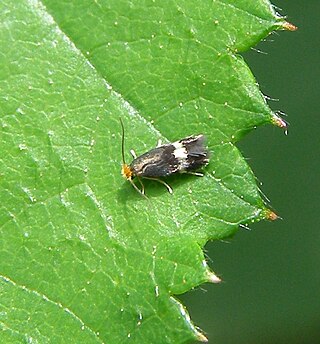
Stigmella aurella is a moth of the family Nepticulidae found in Africa, Asia and Europe. It was first described by the Danish zoologist, Johan Christian Fabricius in 1775. The larvae are leaf miners.

Stigmella crataegella is a moth of the family Nepticulidae found in Europe. It was described by the Austrian entomologist Josef Wilhelm Klimesch in 1936. The larvae mine the leaves of hawthorns.

Stigmella perpygmaeella is a moth of the family Nepticulidae, found in most of Europe, east to Russia. The larvae mine the leaves of hawthorns.

Ectoedemia atricollis is a moth of the family Nepticulidae found in Asia and Europe. It was described by the English entomologist Henry Tibbats Stainton in 1857.

Micropterix tunbergella is a moth of the family Micropterigidae found in most of Europe. The moths are very small and can be found feeding on the pollen of hawthorn, oak and sycamore. The larva and pupa are unknown. The moth was described Johan Christian Fabricius in 1787.
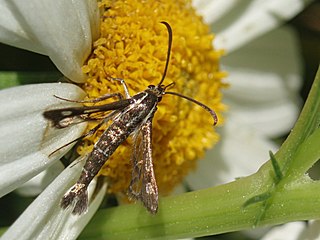
Pyropteron muscaeforme, the thrift clearwing, is a moth of the family Sesiidae that lives in most of Europe.

Coleophora argentula is a moth of the family Coleophoridae, found in most of Europe, Russia and Asia Minor. The larvae live in cases and feed on the seeds of yarrow and sneezewort.

Coptotriche marginea is a moth of the family Tischeriidae, found in most of Europe. It was named by the English botanist, carcinologist and entomologist, Adrian Hardy Haworth in 1828, from a specimen found in England. The larvae mine the leaves of brambles (Rubus) species.

















